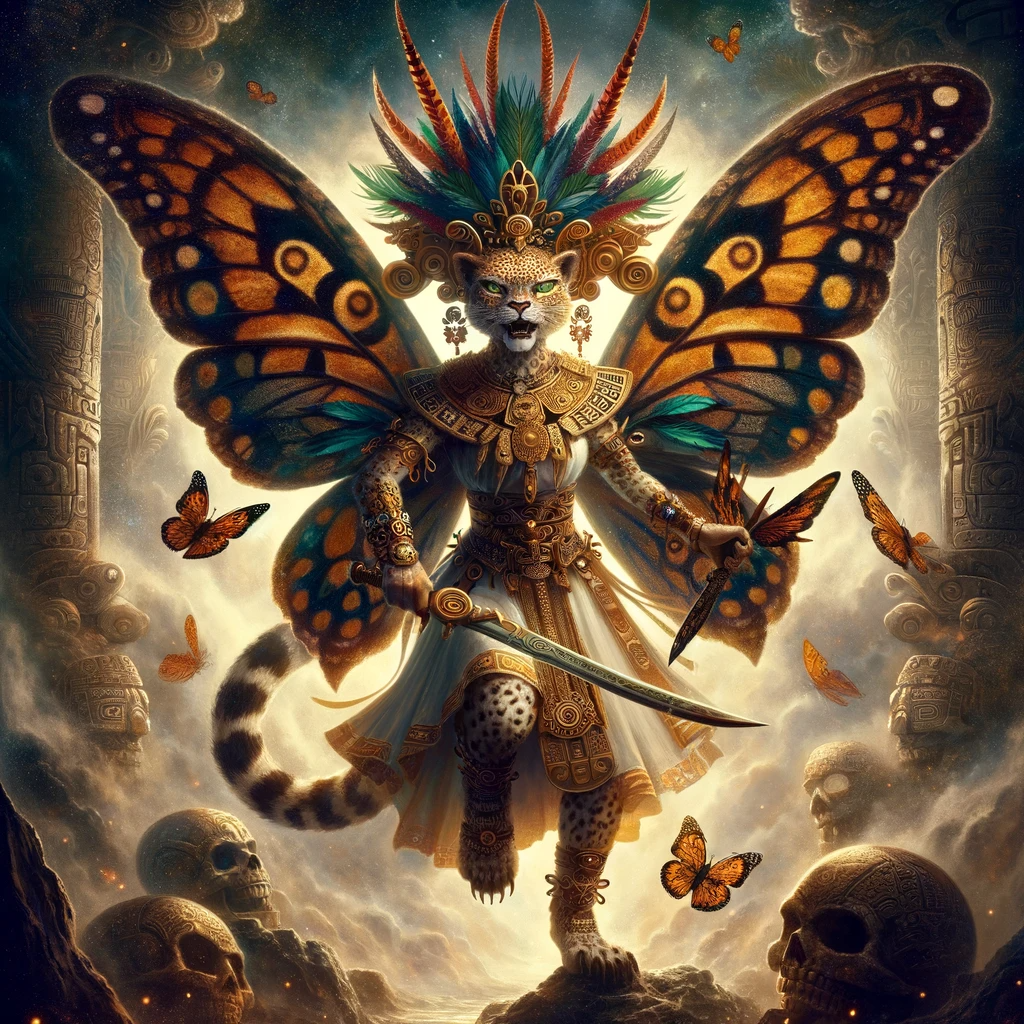
In the pantheon of Aztec mythology, Itzpapalotl stands out as one of the most intriguing and multifaceted deities. Her name, translating to "Obsidian Butterfly" or "Clawed Butterfly" in Nahuatl, the language of the Aztecs, reflects her dual nature as both a beautiful, delicate entity and a fierce, warlike spirit.
Mythological Origins
Itzpapalotl is often associated with the Tzitzimime, celestial demons or star deities, particularly during solar eclipses when they were believed to attack the sun. She is also linked to the earth, specifically the realm of the dead. As a deity, Itzpapalotl's origins are shrouded in mystery, with various myths attributing her to different roles and powers. Some tales depict her as a leader among the Tzitzimime, while others describe her as a solitary figure.
Appearance and Symbolism
Itzpapalotl's iconography is as complex as her mythology. She is often depicted with features of both a beautiful, graceful butterfly and a fierce warrior. Her butterfly wings are typically adorned with obsidian, a volcanic glass known for its sharpness and used in Aztec weaponry. This combination symbolizes transformation, beauty, and danger. Additionally, she is sometimes portrayed with attributes of a jaguar, another symbol of power and ferocity in Aztec culture.
Role in Aztec Rituals and Cosmology
In Aztec rituals, Itzpapalotl played a significant role. She was particularly venerated during certain festivals and was considered a patroness of warriors. Her association with both the earth and the stars placed her in a unique position in Aztec cosmology, bridging the gap between the mortal world and the celestial realm. Warriors who died in battle were believed to join her in the afterlife, transformed into hummingbirds or moths.
Cultural Significance and Modern Interpretation
In modern times, Itzpapalotl continues to be a subject of fascination and study. Her dual nature has led to various interpretations, with some viewing her as a symbol of the struggle between life and death, beauty and danger, or transformation and permanence. For many, she embodies the complexity of human nature and the universe itself.
Conclusion
Itzpapalotl's enduring legacy in Aztec culture and mythology is a testament to the rich and intricate belief systems of the Aztecs. As a deity of war, death, and beauty, she encapsulates the multifaceted nature of existence and the universe. Her story continues to inspire and intrigue, offering insights into the ancient world and its understanding of the divine.
Mythological Origins
Itzpapalotl is often associated with the Tzitzimime, celestial demons or star deities, particularly during solar eclipses when they were believed to attack the sun. She is also linked to the earth, specifically the realm of the dead. As a deity, Itzpapalotl's origins are shrouded in mystery, with various myths attributing her to different roles and powers. Some tales depict her as a leader among the Tzitzimime, while others describe her as a solitary figure.
Appearance and Symbolism
Itzpapalotl's iconography is as complex as her mythology. She is often depicted with features of both a beautiful, graceful butterfly and a fierce warrior. Her butterfly wings are typically adorned with obsidian, a volcanic glass known for its sharpness and used in Aztec weaponry. This combination symbolizes transformation, beauty, and danger. Additionally, she is sometimes portrayed with attributes of a jaguar, another symbol of power and ferocity in Aztec culture.
Role in Aztec Rituals and Cosmology
In Aztec rituals, Itzpapalotl played a significant role. She was particularly venerated during certain festivals and was considered a patroness of warriors. Her association with both the earth and the stars placed her in a unique position in Aztec cosmology, bridging the gap between the mortal world and the celestial realm. Warriors who died in battle were believed to join her in the afterlife, transformed into hummingbirds or moths.
Cultural Significance and Modern Interpretation
In modern times, Itzpapalotl continues to be a subject of fascination and study. Her dual nature has led to various interpretations, with some viewing her as a symbol of the struggle between life and death, beauty and danger, or transformation and permanence. For many, she embodies the complexity of human nature and the universe itself.
Conclusion
Itzpapalotl's enduring legacy in Aztec culture and mythology is a testament to the rich and intricate belief systems of the Aztecs. As a deity of war, death, and beauty, she encapsulates the multifaceted nature of existence and the universe. Her story continues to inspire and intrigue, offering insights into the ancient world and its understanding of the divine.